Going Mobile
Today's lightweight, portable blinds offer concealment and mobility in the field and on the water
Today's lightweight, portable blinds offer concealment and mobility in the field and on the water

When it comes to putting together a successful hunt for ducks or geese, few pieces of the puzzle are more important than concealment. The slightest shuffle or anxious glance from hunters is enough to send wary waterfowl on their way.
In recent decades, mobile blinds have revolutionized the way hunters avoid the watchful eyes of waterfowl, allowing us to stay comfortable and hidden while also affording us the opportunity to pull up stakes and move to exactly where the birds want to be. Read on to find out how four expert waterfowlers EMPLOY different types of mobile blinds, and how you can use one of these portable hides to improve your chances for success this season.

Photo Jim Thompson
Generations of waterfowl hunters have used box-style or A-frame blinds, but modern, collapsible versions have made this concealment method more popular than ever. "For many models, you can fold them up and throw them in the back of a truck with no problem, but in the field they provide a great hide and you've got a little room too," says veteran guide and South Dakota hunter Ben Fujan. "I think folks enjoy being able to move around a bit inside the blind, pour a cup of coffee, and have the chance to visit quietly without disrupting the hunt."
Fujan uses a custom-built A-frame blind to conceal hunters in a variety of settings when hunting ducks or geese. He often sets up on field edges because the taller cover helps break up the outline of the blind, but he sometimes sets up using natural features within a field too.
"Even when I'm trying to shoot mallards in a field of combined corn, I'll set up in a finger of cover in the field if it gets me a little closer to the X or provides a better use of the sun and the wind," Fujan says. "It does not have to be the heaviest cover. I'll use anything I can to break up the profile of the blind."
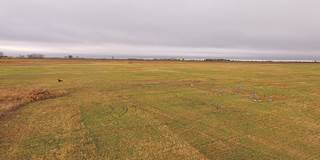
Photo Travis Mueller/Avery Outdoors
Fujan says that one advantage of hunting along a field edge is that it often forces ducks and geese to work in front of the blind, as the birds tend to not want to work across a fence or taller cover. "Really, I'm a firm believer in not putting any decoys behind me any time I'm hunting out of an A-frame. Everything is out front. I don't want birds trying to land behind me, which is especially important on calm days," he says.
For safety, Fujan keeps dogs outside of the blind. "When I'm dealing with guns and maybe heaters in a small space, I just don't want to throw a dog in the mix, and I also think that they have a hard time marking birds, even if there is a door," he says. "I always try to put them in their own blind somewhere in the shadow of the A-frame."
Cover on top of the blind is a crucial element for concealing hunters in A-frames. Fujan places plenty of grass over the heads of the hunters, who are seated on director-style camp chairs. "I know buckets are popular, but I think they're too low. I like to have hunters sit a little higher, so that their caps are level with the lid of the blind. I think they actually move around less, because they aren't straining to try and see birds working," he says.
Fujan employs the help of the other hunters to make the finishing touches on the blind. When planning for a morning hunt, he always blocks off the last 15 to 20 minutes for blind work. After the blind is put together and in place and the decoys are set up, he hands out zip ties and tells the others to rake up corn stalks or other vegetation from the surrounding area to make bundles of cover. He'll attach many of the bundles to the sides of the blind and add others overhead. The rest go by his side to be added as needed throughout the morning. "When it's done, we take our places, pour cups of coffee, sit back, and wait for the show to start," he says.
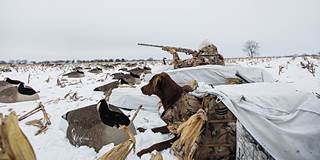
With the right kind of camo applied, you can use a portable blind in virtually any setting and under any condition.
Photo Nicole Belke
With their light weight and ability to provide low-profile concealment in just about any type of cover, layout blinds have become a top choice for hunters across the flyways, whether they are targeting mallards and pintails in an Alberta stubble field or decoying brant along the edges of a wind-whipped salt marsh in New England.
"The layout blind works in so many situations because you're not dependent on an edge or fence line to provide the background necessary to hide a traditional blind. You're able to use the available horizontal and vertical cover exactly where the birds want to be," says Connecticut hunter and guide Spencer Proulx. "In terms of concealment, I'm not sure if any other piece of gear has had the impact that layout blinds have had. They were a game changer when they first came out, and they remain a great option for hunters today."
The layout blind likely sees the most action while hunting in fields of harvested crops, but these blinds can also help hide you along wetland edges, on riverbanks and sandbars, and even on ice while using a white cover. The first step toward staying hidden in just about any of these situations, however, takes place before a blind's first use. "New blinds have a sheen that needs to be softened, so you can apply a layer of mud using your hands or even a cheap paint brush, or you can lightly spray it with a coat of flat black or brown spray paint," Proulx says. "The idea is to get rid of that shine and create a background of natural color that matches the tone of the ground as you'd see it from the air."
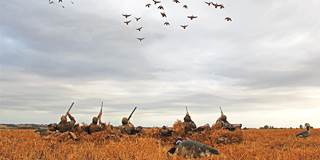
Photo GARYKRAMER.NET
As a next step, and to help save time in the field, Proulx recommends using zip ties to attach a base layer of grassreal or manufacturedto a blind's stubble straps. "The manufactured grass stands up a little better over the course of a season, and it is available in a lot of different colors to match different hunting scenarios," he says. "I keep a set of blinds with a base of green grass to use in alfalfa or similar situations and then another set with a base more suited for wheat stubble or corn. From there it is really important to top them off in the field using the exact cover you're hunting in, making them look as natural as possible. Keeping a plastic rake and hedge trimmer in your truck or trailer will help save a lot of time getting this done."
While it is ideal to set up exactly on the X in the field, Proulx tries to use any nearby dips or natural depressions where he can place the blinds to lower their profile. It also helps to set up in areas of taller stubble or other vertical cover, he says, to take advantage of shadows and break up the outline of the blind.
Blind spacing is also important. "Perhaps the biggest change I've made since I started using layout blinds is to move away from putting much space in between the blinds, especially if I'm hunting with a larger group," Proulx explains. "The birds seem to key in on individual blinds, but they seem less wary of blinds set closely side by side, which appear more like a natural contour in the field."
Even with all the advantages provided by a layout blind, Proulx says hunters always need to remember one important rule: If you can see the birds, they can see you. "The headrest in the blind is just thata headrest. It is not a shoulder rest," he says. "It's tempting to poke your head up and look around, but even if the rest of your hide is great, the birds are going to see that movement and flare."
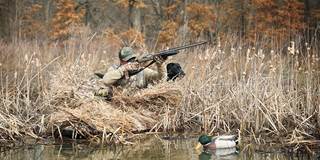
Photo Higdon Outdoors/MOMARSH.COM
While boats have long been used by hunters to access hard-to-reach places, many modern waterfowling boats have taken mobility and concealment to the next level. This includes hunting in managed areas of flooded crops and moist-soil vegetation, where small, shallow-draft boats equipped with covers and blind doors provide layout-style hunting on the X.
"With this style of boat, you are completely mobile, and you can hunt in just inches of water. And because the boat has such a low profile, you can hide in anything," says Missouri hunter Josh Ditch, a pro-staffer for MOmarsh. "You can hunt just about anywhere the birds want to be from day to day."
Ditch does much of the concealment work on his boat blind before the hunt, using zip ties to attach several layers of synthetic grass in different colors to the blind to provide a foundation that breaks up the outline of the boat. "This way, all I have to do is grab a few handfuls of smartweed or cut off a few branches of buck brush to throw on top of the boat when I get to the spot I'm hunting," he says. "I tuck the boat back up in the weeds or the corn or up against the trees, throw out my decoys, and I'm ready."
The size and mobility of the boats make adjusting to the sun, wind, or bird behavior that much quicker, too. "It is nothing to hop out, move the boat 180 degrees, or slip it to the side to get the sun at your back," Ditch says. "These small boats can do a lot."

Photo Phil Kahnke/BANDED.COM
Bigger waters require a bigger boat, but the goal remains the sameuse the boat to hunt in a place where birds want to be. "If done right, a bigger boat allows you to stay concealed and comfortable. Hands down, it is my favorite way to hunt ducks and geese," says Avery Outdoors Content Manager and duck boat aficionado Phil Kahnke.
Finding the X on lakes, rivers, or large wetland complexes requires scouting, which is something best done from the boat, if possible. "I've gotten into situations where, from the road, a cattail edge or finger of cover looks one way, but on the water the reeds are really sparse or there is a big mud flat or something like that," Kahnke explains. "If you can do it without spooking a lot of birds, it really helps to get out there in the boat before you try to hunt."
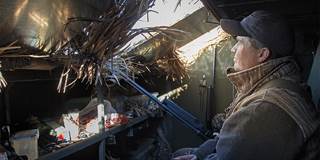
Larger boats with integrated blinds can be just the ticket for hunting big waters.
Photo Phil Kahnke/BANDED.COM
Kahnke grew up hunting out of boats in Minnesota and to date has designed four boat blinds. His latest version is a customized blind built on an 18-foot-long, 5-foot-wide modified V-hull johnboat that can accommodate three hunters and a dog. For a boat this size, Kahnke looks for areas that will provide good cover in front of the boat and cover tall enough in back to help cast shadows. "I'm always concerned about breaking up the black holes,' or those openings that provide hunters with a little visibility," he says. "I keep bundles of grass in the boat for this reason, and I add them as needed."
Hunting from a boat comes with plenty of safety concerns. A layer of closed-cell foam underfoot helps provide a nonslip surface for hunters, and a dog box outside the blind provides a safe spot for Kahnke's retriever while ensuring guns and heaters inside the blind are undisturbed by an energetic Labrador.
Ducks Unlimited uses cookies to enhance your browsing experience, optimize site functionality, analyze traffic, and deliver personalized advertising through third parties. By continuing to use this site, you agree to our use of cookies. View Privacy Policy